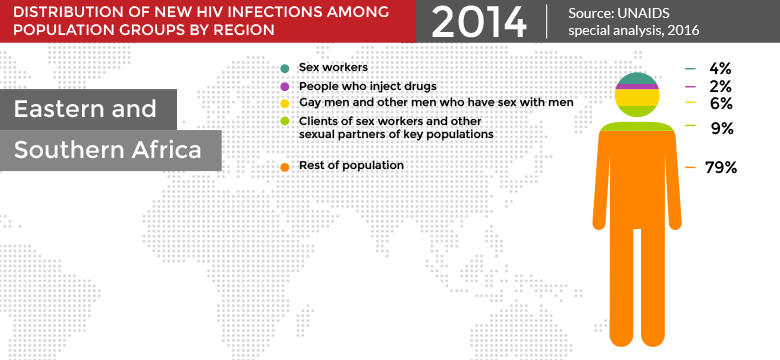Biologic vulnerability in women
Several studies have indeed found that women have higher risk of contracting HIV upon exposure to the virus than men. A prospective study of 730 serodiscordant Italian couples showed that the efficiency of male-to-female transmission was 2.3 times greater than female-to-male transmission; Padian’s prospective study of 442 of serodiscordant couples in Northern California showed male-tofemale transmission was approximately eight times more efficient than female-to-male transmission. Additionally, despite several studies showing that male circumcision confers reduced HIV transmission risk for males, a randomized controlled trial in Uganda was stopped early as it found that circumcision of HIV infected males did not reduce HIV transmission to their female partners The potential reasons for this increased biologic susceptibility are several, though many of them are difficult to prove directly. Women often have increased duration of exposure to infectious fluids during heterosexual vaginal sex, which may allow more time for the virus to enter cervical or vaginal tissue. Cells lining the cervix and vagina provide a more permeable membrane to HIV than the penile shaft. This appears to be especially likely if there is an endocervical component of the cervix that is exposed at the cervical os; columnar epithelial cells are likely demonstrate less of a barrier to HIV and other viruses than the squamous cells in the rest of the cervix. Further, it was demonstrated that young women are more likely than older women to have an exposed endocervical component of their cervix, further increasing their risk of HIV. Untreated sexually transmitted infections (STDs) such as herpes
Multiple partners’ vs. long term concurrent partners
Though there is clearly evidence of increased biologic vulnerability for females, several other factors may play a role in the higher rates of HIV seen in women. Young age at sexual debut and increasing numbers of lifetime sexual partners both have been associated with HIV risk due to the increased likelihood of exposure with greater numbers of sexual experiences. While this seems logical, nuanced differences in sexual experience, whether a partner is acutely infected with HIV and thus has an elevated viral load, how long the partnerships last, and the level of trust between the partners can all be important determinants of HIV risk. Despite the common view that individuals in Africa have higher rates of HIV because they are more promiscuous than individuals in other parts of the world, this has been shown to be a misconception. Men and women in Africa typically do not have more sexual partners than those in other parts of the world based on comparative studies of sexual behavior, however it has been observed that men and women in African countries are more likely to have more than one long term concurrent partner than in other parts of the world.24 In a mathematical model created by Morris and Kretzschmar which compared the spread of HIV in a population where serial monogamy was the norm against a population where long term concurrency was common, the risk of HIV spread was found to be ten times higher in the latter population with concurrent relationships.25 Halperin also postulated that because the spread of HIV is much more effective when viral load is high in the first weeks or months after initial infection, a network of concurrent relationships can be much more profoundly impacted by one new case of HIV than in a network of couples practicing serial monogamy.24 Shannon et al in their 2012 cross sectional study using surveys of 2049 individuals in Botswana and Swaziland found that 39% of men and 18% of women reported concurrent sex partners in the last year.26 One study also found evidence that while condom use is fairly common in brief sexual encounters (such as in paid sexual encounters with prostitutes), it may be less common in long term relationships where there is a degree of commitment and trust.
Intergenerational Relationships
Another hypothesis that might explain why HIV rates are much higher in young women in sub Saharan Africa has been the relative frequency of relationships where a younger female is in a sexual partnership with an older man. As discussed above, older men might be both supported by cultural norms which favor multiple concurrent sexual partnerships and are also more likely to be sexually experienced as their age increases, thus putting less sexually experienced females at potentially higher risk for HIV. An intergenerational relationship has been defined in the literature as one in which one partner is 10 or more years older than the other, while an age-disparate relationship refers to one where the age gap is 5 years or more.33 Several studies have demonstrated fairly high rates of intergenerational relationships in Africa. In Shannon’s study of 2,049 individuals in Botswana and Swaziland, 15% of men reported intergenerational sex, while 17% of women reported this type of relationship.26 Wyrod et al. completed surveys and HIV testing of 1,313 men encountered in beer halls in urban Zimbabwe in 2002-2003; that study found that 25% of men described participating in an intergenerational relationship in the past 6 months. Luke, in her 2003 paper on age and economic asymmetries in sexual relationships in Sub- Saharan Africa, reviewed 16 different sources for evidence and prevalence of age asymmetric relationships. As Luke herself admitted, it is difficult to compare results of these studies as their sampling strategies, measurement methods, and types of statistics used vary widely. She reported though that few studies found that girls had partners that were the same age, and on average, the mean age difference was between 2 to 7 years older for women’s partners. She also found that as adolescent girls mature, the age difference between them and their partners increase in general. Overall, she asserted that engaging in sexual relationships with older partners is common for women in sub-Saharan Africa, although it is challenging to accept a definitive statement about the prevalence of these relationships when reviewing the sources of variable quality from which she draws her conclusions.



